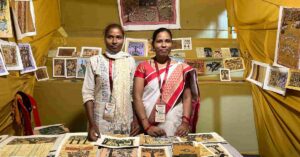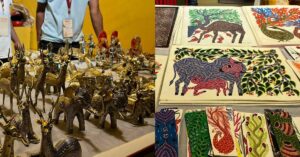How a Unique Conclave Celebrates The Cultural Wealth of 200 Tribes of India
Tata Samvaad, enabled by the Tata Steel Foundation in Jharkhand, brings together 200 tribal communities annually to celebrate their rich culture and identity through art, food, workshops, and conversations.
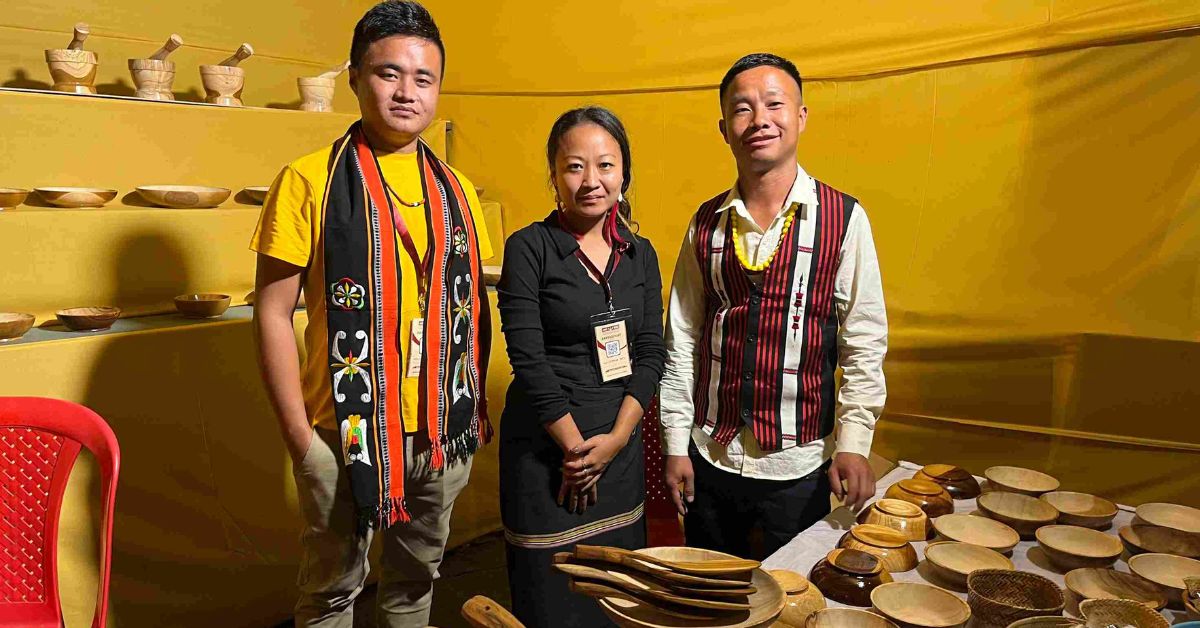
This article has been published in partnership with Samvaad – Enabled by Tata Steel Foundation
Standing next to women dressed in colourful sarees, Pritesh Kumar Khalko looked out of place at first in his black jacket at Jamshedpur’s Gopal Maidan. He looked tired, but that did not stop him from excitedly inviting strangers to his food stall and narrating the fascinating story behind each dish.
“The baas (bamboo) pickle is good for your blood, and the hau chutney made from red weaver ants is rich in protein and calcium. Jamun powder helps control sugar; you will not find this anywhere else in India,” he told the potential customer at his stall.
The conviction in his tone changed as The Better India team asked about how his community cuisine could help his tribe do better. “Provide us platforms like Samvaad where we can share our culture and food, and most importantly, help us tell our own stories,” he said.
Pritesh’s focus on preserving his tribal identity through cuisine mirrored the essence of Samvaad — Enabled by Tata Steel Foundation (TSF), which brings together the diverse tribes of India on one platform for a five-day-long festivity, which lets everyone immerse in tribal art, culture, and traditions.
Pritesh belongs to one of the 200 tribal communities participating in Samvaad — a major tribal conclave which brings together tribes of the nation and beyond. It is emerging to be one of the most prominent platforms for dialogues on tribal discourse in India.
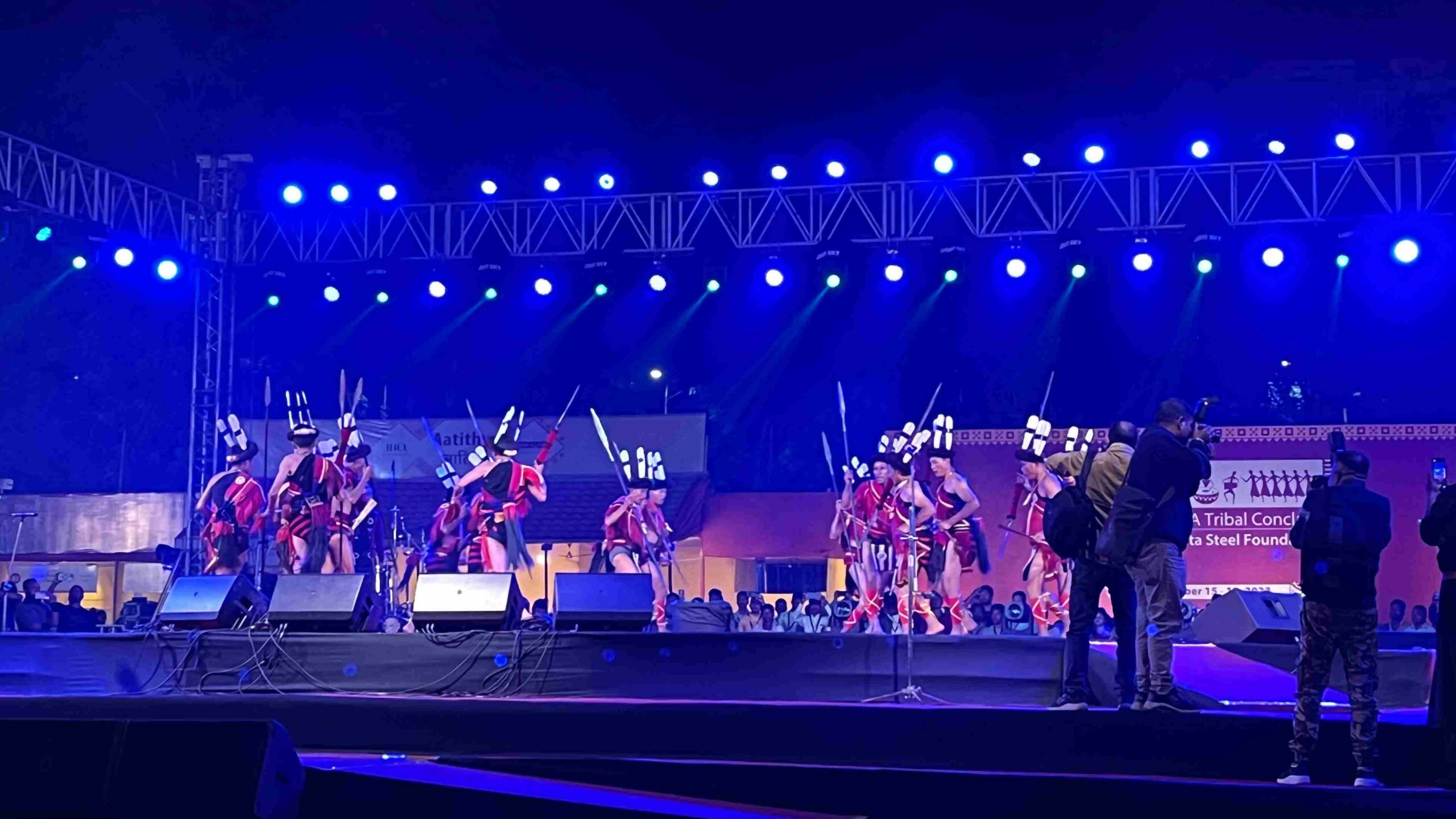
Strengthening the footprints of tribal identity
There are 13 elements of Samvaad, which have emerged over the years, creating a permanent space for dialogue and conversations that are poised to tackle some of the challenges that lie ahead. This annual conclave not only celebrates tribal art and culture but also fosters dialogue to drive change in rural areas.
Held from 15 to 19 November each year, Samvaad honours the legacy of Birsa Munda — a tribal independence activist and leader from Jharkhand’s Munda tribe. In its tenth year, themed ‘Walk with Me’, Samvaad reflected on a decade of impactful dialogues, recognising the journey of ideas and changemakers shaping the present and future.
“The different elements of Samvaad, including food, music, artisans, cultural markers, and others, bring a lot of intangible potential through this tribal cultural conclave. It is not only a platform of expression but also a forum for meaningful dialogues that add perspectives to the different aspects of life and one’s journey through it,” said Sourav Roy, CEO of TSF.
He continued, “Throughout the year, we engage with the tribes through our initiatives to converge on dialogues that set the tone for Samvaad each year. Many new ideas and innovations emerge from these conversations, moderated by experts from respective fields and changemakers from all over the country. Celebration of culture also forms an integral part of Samvaad, which not only generates livelihood for tribal artisans but also allows people to appreciate their unique traditions, passed down through generations, rich in wisdom.”
Samvaad’s varied ecosystem
The magnitude of Samvaad is reflected in its diverse ecosystem, which includes promoting tribal healers, artisans, cuisines, languages, sports and heritage conservation, Akhra, Samudaay ke Saath, Rhythms of the Earth, Tribal Leadership Programme, Samvaad Fellowship, and Samvaad Action Research Collective.
The Samvaad Fellowship aims to guide and nurture individuals committed to preserving tribal culture and heritage through community-based action. After a round of assessments, the fellows receive one-year grants and mentorships from academicians and experts. These fellowships have led to tangible outcomes like tribal dictionaries, song recordings, story books for children, collectives and more.
“From contesting elections to making documentaries on tribal issues, many people have emerged as leaders and changemakers. Some have even failed. Irrespective of your failure or success, you have made friends who will always support you. And that is what Samvaad aims to be,” says Jiren Xavier Topno, Head of Tribal Identity at TSF.
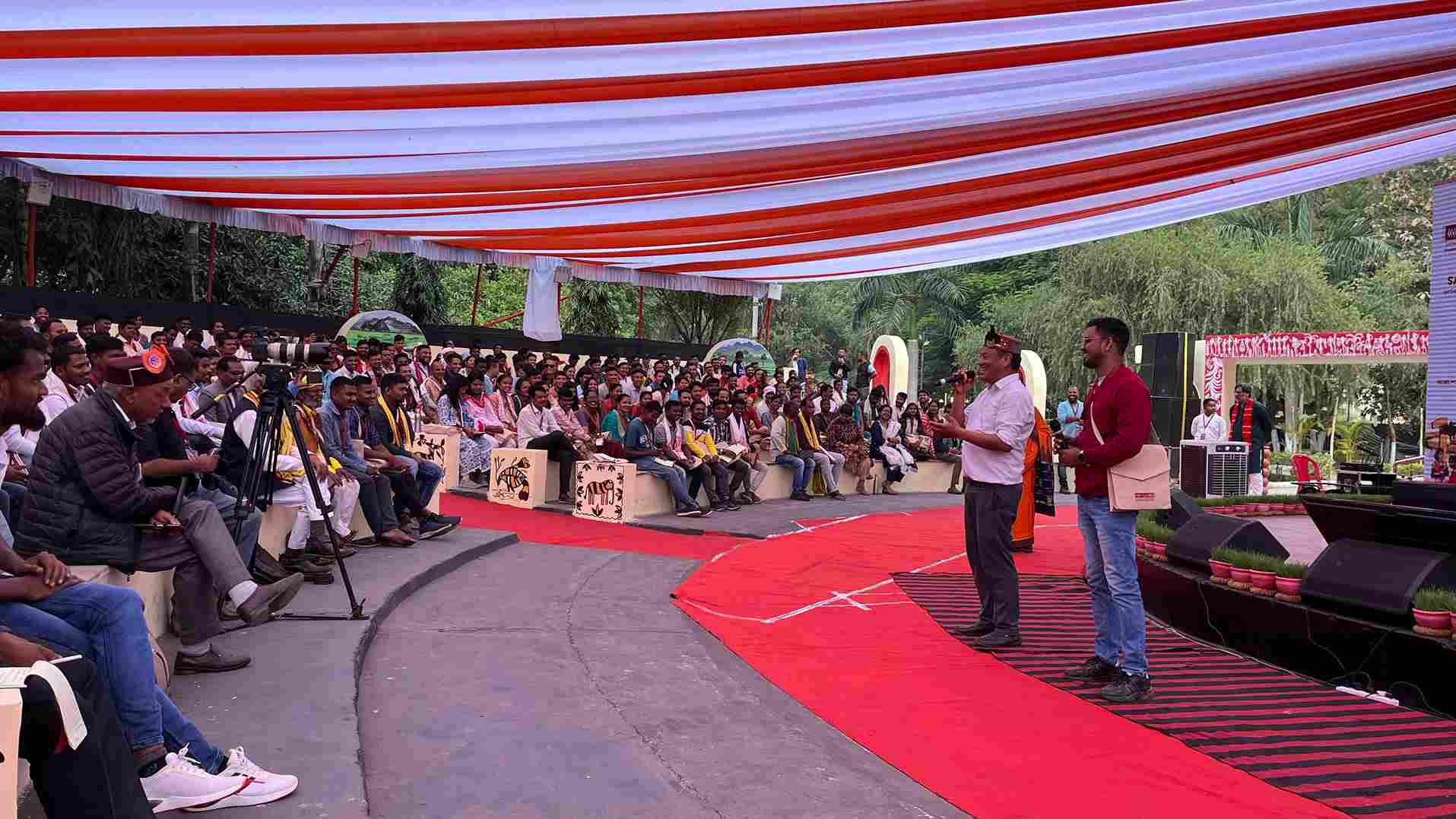
Samvaad’s ‘10tak at Akhra’, is another way in which the conclave served as a platform where individuals from diverse tribal groups came together to share their journey of change, challenges, and possible solutions. As Samvaad stepped into its tenth year, over 500 people gathered to share their inspiring stories at the open-air Amphitheatre at the Tribal Cultural Centre (TCC).
Aakash Pawar, instigated by the rising farmer suicides across Maharashtra, fought for his rights and now runs constitution schools to educate his community about their rights; Manasi from Odisha helped bring back thousands of migrant labourers amid the pandemic by being a citizen journalist; and Garima Siddhar is a lawyer providing justice to tribal communities. These changemakers are now a part of the tribal leadership programme alumni, which is over 400- members strong, who have stayed connected to share their narratives of change to inspire others.
From a cultural lens, Samvaad organises a grand inaugural show every year at Gopal Maidan. This year, 251 nagadas, dhols and musical instruments reverberated in homage to Birsa Munda. The tribals adorning bright yellow vests with white dhotis, played various goosebump-inducing songs — from the bonga taal, baika taal to the santal taal.
Dancers and singers participated in cultural performances as people gorged on tribal delicacies, shopped for vibrant artefacts (handcrafted by the same artisans who are selling them), and danced to the tribal beats.
“This is my tenth year and I have been a part of Samvaad since the beginning. I love the energy here. Of course, the highlight is selling our Oraon paintings,” said Sumanti Devi, a painter from Chhattisgarh. “Very few people knew about our paintings before, but now it is more popular. Initially, it was only handicrafts stalls, but Samvaad has grown so much with Akhara, fellowship, tribal healers, Tribal Leadership Programme and more.”
Meanwhile, Choisa Hakong from the Chakesang tribe (Nagaland) was at the conclave for the first time. “Samvaad is connecting tribals as one in spirit and culture. I am so happy to attend and showcase our products made from teak and bamboo,” he said.
Over the five days, Pritesh, Sumanti, and Choisa, along with people from 110 other tribes, displayed their cuisine, artwork, and healing practices. Besides the stalls, 140 home chefs from 37 tribes offered home delivery via the Zomato app.
The role of these artisans goes beyond selling their products. They also refine their skills through workshops and sessions led by handicraft experts, engage in healing practices, and showcase their culinary talents.
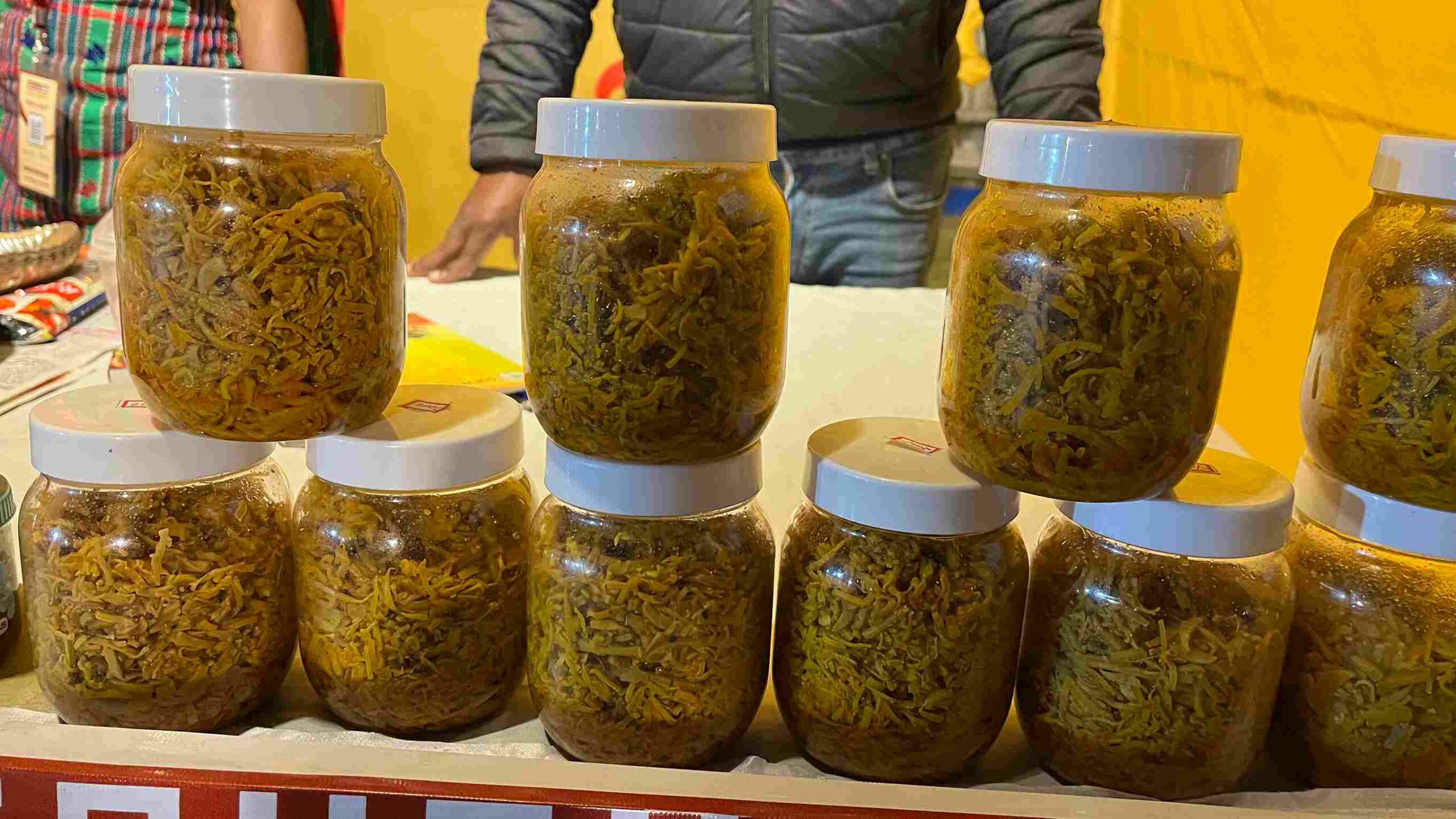
A tangible difference
Looking over the last decade of Samvaad, the initiative has seen a visible impact, bringing together over 40,000 people from India and 17 other countries. The beauty of this conclave is that it extends beyond the five days; the dialogue and actions continue throughout the year. This meticulous approach has led to outcomes that once seemed far-fetched.
Take, for example, ‘Rhythms of the Earth’ — an ensemble of tribal musicians from across the country composed and launched five original compositions on a tribal narrative at the conclave. The compositions are on the theme of unifying tribals in the face of adversity. They include ‘Nukhtharini Juwmang’ by the Rabha tribe, ‘Eklaivet Ajakong’ by the Karbi tribe, ‘Dela Dela’ by the Santal tribe, ‘Abua Disom’ from the Ho tribe and more.
Another significant outcome of Samvaad’s ten-year journey was seen in Jaincy John’s struggle to break away from the conventional narrative of urban education. Living in cities often limits our view of education to securing future jobs. However, for those in remote areas far from mainstream society, education is about identity and challenging stereotypes built over the years.
An academician and activist from Kerala’s Mala Arya community, Jaincy challenged the stereotypes around tribal identity. While she was working on extensive pieces on Adivasi and Dalit art, culture, and history, and completing her PhD, she encountered discrimination and abuse from her guide. However, that did not deter her from her path. She filed a complaint against him, which further helped other women open up about their similar experiences.
While Jancy continues to fight the legal battle, Samvaad has supported the right of many tribal members to represent themselves: “Nothing about us without us”.
This is important because tribal individuals deserve recognition as prominent leaders, and Samvaad is dedicated to amplifying their visibility. The conclave advocates for inclusivity and equality, ensuring that everyone has a voice and uniting those who have faced exploitation due to their identity. Today, members of tribal communities are not simply demanding a seat at the table; they are actively forging one. If you found our stories insightful, informative, or even just enjoyable, we invite you to consider making a voluntary payment to support the work we do at The Better India. Your contribution helps us continue producing quality content that educates, inspires, and drives positive change. Choose one of the payment options below for your contribution- By paying for the stories you value, you directly contribute to sustaining our efforts focused on making a difference in the world. Together, let’s ensure that impactful stories continue to be told and shared, enriching lives and communities alike. Thank you for your support. Here are some frequently asked questions you might find helpful to know why you are contributing?

(Edited by Pranita Bhat; All photos courtesy: Samvaad by Tata Steel Foundation)
This story made me
-
97
-
121
-
89
-
167




